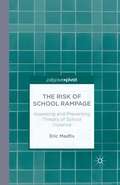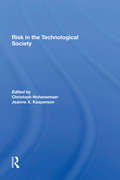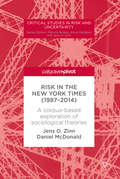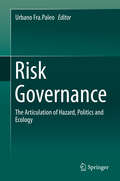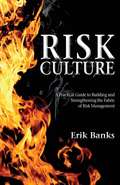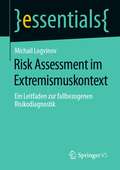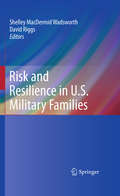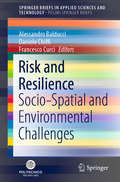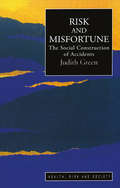- Table View
- List View
Risk, Power, and Inequality in the 21st Century
by D. CurranRisk, Power, and Inequality in the 21st Century provides a groundbreaking new analysis of the increasingly important relationship between risk and widening inequalities. The massive, and often unequal, impacts of contemporary risks are recognized widely in popular discussions – be it the fall-out from the 2008 financial crisis or Hurricane Katrina – yet there is a distinct neglect in social science of the overall systemic impacts of these risks for increasing inequalities. This book moves beyond this lacuna to identify novel intersections of risk and inequalities. It shows how key processes associated with risk society – the social production and distribution of risks as side-effects – are intensifying inequalities in fundamental ways. In articulating how risk is intensifying both the social sources of suffering of the least advantaged and the power of the most advantaged, this book realizes a significant rethinking of risk, power, and inequalities in contemporary society.
The Risk of School Rampage: Assessing And Preventing Threats Of School Violence
by E. MadfisBy examining averted school rampage incidents, this work addresses problematic gaps in school violence scholarship and advances existing knowledge about mass murder, violence prevention, bystander intervention, threat assessment, and disciplinary policy in school contexts.
The Risk of Downward Mobility in Educational Attainment: Children of Higher-Educated Parents in Germany (Life Course Research)
by Sophie HahnSophie Hahn analyses downward mobility in educational attainment from a sociological life-course perspective. In order to avoid status loss children of higher-educated parents have to persevere through long educational careers. How large is their risk of intergenerational downward mobility in educational attainment and how does it shape their educational pathways? Does their parents’ education still play a role in decisions at late stages of the educational career such as dropping out of and re-entering higher education? Drawing on retrospective longitudinal data of the German National Education Panel Study (NEPS) this book addresses these questions.
The Risk of a Lifetime: How, When, and Why Procreation May Be Permissible
by Rivka WeinbergHaving children is probably as old as the first successful organism. It is often done thoughtlessly. This book is an argument for giving procreating some serious thought, and a theory of how, when, and why procreation may be permissible. Rivka Weinberg begins with an analysis of the kind of act procreativity is and why we might be justifiably motivated to engage in it. She then proceeds to argue that, by virtue of our ownership and control of the hazardous material that is our gametes, we are parentally responsible for the risks we take with our gametes and for the persons that develop when we engage in activity that allows our gametes to unite with others and develop into persons. Further argument establishes that when done respectfully, and in cases where the child's chances of leading a life of human flourishing are high, procreation may be permissible. Along the way, Weinberg argues that the non-identity problem is a curiously common mistake. Arguments intending to show that procreation is impermissible because life is bad for people and imposed on them without their consent are shown to have serious flaws. Yet because they leave us with lingering concerns, Weinberg argues that although procreation is permissible under certain conditions, it is not only a welfare risk but also a moral risk. Still, it is a risk that is often permissible for us to take and impose, given our high level of legitimate interest in procreativity. In order to ascertain when the procreative risk is permissible to impose, contractualist principles are proposed to fairly attend to the interests prospective parents have in procreating and the interests future people have in a life of human flourishing. The principles are assessed on their own merits and in comparison with rival principles. They are then applied to a wide variety of procreative cases.
The Risk of a Lifetime: How, When, and Why Procreation May Be Permissible
by Rivka WeinbergHaving children is probably as old as the first successful organism. It is often done thoughtlessly. This book is an argument for giving procreating some serious thought, and a theory of how, when, and why procreation may be permissible. Rivka Weinberg begins with an analysis of the kind of act procreativity is and why we might be justifiably motivated to engage in it. She then proceeds to argue that, by virtue of our ownership and control of the hazardous material that is our gametes, we are parentally responsible for the risks we take with our gametes and for the persons that develop when we engage in activity that allows our gametes to unite with others and develop into persons. Further argument establishes that when done respectfully, and in cases where the child's chances of leading a life of human flourishing are high, procreation may be permissible. Along the way, Weinberg argues that the non-identity problem is a curiously common mistake. Arguments intending to show that procreation is impermissible because life is bad for people and imposed on them without their consent are shown to have serious flaws. Yet because they leave us with lingering concerns, Weinberg argues that although procreation is permissible under certain conditions, it is not only a welfare risk but also a moral risk. Still, it is a risk that is often permissible for us to take and impose, given our high level of legitimate interest in procreativity. In order to ascertain when the procreative risk is permissible to impose, contractualist principles are proposed to fairly attend to the interests prospective parents have in procreating and the interests future people have in a life of human flourishing. The principles are assessed on their own merits and in comparison with rival principles. They are then applied to a wide variety of procreative cases.
Risk Management, 2 Volume Set (Routledge Revivals)
by Gerald Mars David WeirFirst published in 2000, Risk Management is a two volume set, comprised of the most significant and influential articles by the leading authorities in the studies of risk management. The volumes includes a full-length introduction from the editor, an internationally recognized expert, and provides an authoritative guide to the selection of essays chosen, and to the wider field itself. The collections of essays are both international and interdisciplinary in scope and provide an entry point for investigating the myriad of study within the discipline.
Risk Management: Insights from Different Settings (Risk, Governance and Society #20)
by Philip Shrives Monika Wieczorek-Kosmala Cristina Florio Philip Mark LinsleyThis volume offers new, convincing empirical evidence on topical risk- and risk management-related issues in diverse settings, using an interdisciplinary approach. The authors advance compelling arguments, firmly anchored to well-accepted theoretical frameworks, while adopting either qualitative or quantitative research methodologies. The book presents interviews and surveys with risk managers to gather insights on risk management and risk disclosure in practice. Additionally, the book collects and analyzes information contained in public reports to capture risk disclosure and perceptions on risk management impacts on companies’ internal organization. It sheds light on financial and market values to understand the effect of risk management on actual and perceived firm’s performance, respectively. Further, it examines the impacts of risk and risk management on society and the economy.The book improves awareness and advances knowledge on the complex and changeable risk and risk management fields of study. It interweaves among topical, up-to-date issues, peculiar, under-investigated contexts, and differentiated, complementary viewpoints on the same themes. Therefore, the book is a must-read for scholars and researchers, as well as practitioners and policy makers, interested in a better understanding of risk and risk management studies in different fields.
Risk In The Technological Society
by Chris Hohenemser Jeanne X KaspersonIn this book, representatives of government, industry, universities, and public interest groups consider the emerging art of risk assessment and discuss the issues and problems involved. They look at two failures in technological risk management–Three Mile Island and Love Canal; examine the dimensions of technological risk; tackle the difficult question of how safe is "safe enough"; and offer a set of research priorities.
Risk In The Technological Society
by Chris Hohenemser Jeanne X KaspersonIn this book, representatives of government, industry, universities, and public interest groups consider the emerging art of risk assessment and discuss the issues and problems involved. They look at two failures in technological risk management–Three Mile Island and Love Canal; examine the dimensions of technological risk; tackle the difficult question of how safe is "safe enough"; and offer a set of research priorities.
Risk in The New York Times: A corpus-based exploration of sociological theories (Critical Studies in Risk and Uncertainty)
by Jens O. Zinn Daniel McDonaldThis book investigates to what extent claims of common social science risk theories such as risk society, governmentality, risk and culture, risk colonisation and culture of fear are reflected in linguistic changes in print news media. The authors provide a corpus-based investigation of risk words in The New York Times (1987-2014) and a case study of the health domain. The book presents results from an interdisciplinary enterprise which combines sociological risk theories with a systematic functional theory of language to conduct an empirical analysis of linguistic patterns and social change. It will be of interest to students and scholars interested in corpus linguistics and digital humanities, and social scientists looking for new research strategies to examine long term social change.
Risk Governance: The Articulation of Hazard, Politics and Ecology
by Urbano Fra. PaleoThis book explores the common language of politics, ecology and risk, and crosses their conceptual divides. It seeks to shed light on the underlying structural factors, processes, players and interactions in the risk scenario, all of which influence decision-making that both increases and reduces disaster risk.The first section explores risk governance under conditions of increasing complexity, diversity and change. The discussion includes chapters on The problem of governance in the risk society; Making sense of decentralization; Understanding and conceptualizing risk in large-scale social-ecological systems; The disaster epidemic and Structure, process, and agency in the evaluation of risk governance. Part II, focused on governance in regions and domains of risk, includes nine chapters with discussion of Climate governance and climate change and society; Climate change and the politics of uncertainty; Risk complexity and governance in mountain environments; On the edge: Coastal governance and risk and Governance of megacity disaster risks, among other important topics. Part III discusses directions for further advancement in risk governance, with ten chapters on such topics as the transition From risk society to security society; Governing risk tolerability; Risk and adaptive planning for coastal cities; Profiling risk governance in natural hazards contexts; Confronting the risk of large disasters in nature and Transitions into and out of a crisis mode of socio-ecological systems.The book presents a comprehensive examination of the complexity of both risk and environmental policy-making and of their multiple—and not always visible—interactions in the context of social–ecological systems. Just as important, it also addresses unseen and neglected complementarities between regulatory policy-making and ordinary individual decision-making through the actions of nongovernmental actors. A range of distinguished scholars from a diverse set of disciplines have contributed to the book with their expertise in many areas, including disaster studies, emergency planning and management, ecology, sustainability, environmental planning and management, climate change, geography, spatial planning, development studies, economy, political sciences, public administration, communication, as well as physics and geology.
Risk, Environment and Modernity: Towards a New Ecology (PDF)
by Mr Bronislaw Szerszynski Professor Brian Wynne Scott M LashThis wide-ranging and accessible contribution to the study of risk, ecology and environment helps us to understand the politics of ecology and the place of social theory in making sense of environmental issues. The book provides insights into the complex dynamics of change in `risk societies'.
Risk Culture: A Practical Guide to Building and Strengthening the Fabric of Risk Management
by E. BanksRisk Culture is a practical volume devoted to the qualitative aspects of risk management, including those that should be firmly embedded in the corporate culture. Through descriptions, examples and case studies, the book analyzes weak and strong cultures and proposes a series of structural and behavioral actions to strengthen a company's culture.
Risk Assessment im Extremismuskontext: Ein Leitfaden zur fallbezogenen Risikodiagnostik (essentials)
by Michail LogvinovDieses essential bündelt das in der Prognoseforschung generierte Wissen über die Risiken und Gefahren der extremistischen Gewalttäter. Nach einer Besprechung internationaler Risk-Assessment-Instrumente wird ein Leitfaden zur Diskussion gestellt, der im engen Austausch mit Fachpraktikern entstanden ist.
Risk and the Public Acceptance of New Technologies
by Rob Flynn Paul BellabyThis edited volume brings together leading social scientists who address recent evidence and debates about public engagement and trust in experts. The chapters consider different methods of public consultation for a variety of new technologies, including genetically modified foods, mobile telecommunications, nanotechnology, and hydrogen energy.
Risk and Technological Culture: Towards a Sociology of Virulence (International Library of Sociology)
by Joost Van LoonThe question as to whether we are now entering a risk society has become a key debate in contemporary social theory. Risk and Technological Culture presents a critical discussion of the main theories of risk from Ulrich Becks foundational work to that of his contemporaries such as Anthony Giddens and Scott Lash and assesses the extent to which risk has impacted on modern societies. In this discussion van Loon demonstrates how new technologies are transforming the character of risk and examines the relationship between technological culture and society through substantive chapters on topics such as waste, emerging viruses, communication technologies and urban disorders. In so doing this innovative new book extends the debate to encompass theorists such as Bruno Latour, Donna Haraway, Gilles Deleuze, Felix Guattari and Jean-François Lyotard.
Risk and Technological Culture: Towards a Sociology of Virulence (International Library of Sociology)
by Joost Van LoonThe question as to whether we are now entering a risk society has become a key debate in contemporary social theory. Risk and Technological Culture presents a critical discussion of the main theories of risk from Ulrich Becks foundational work to that of his contemporaries such as Anthony Giddens and Scott Lash and assesses the extent to which risk has impacted on modern societies. In this discussion van Loon demonstrates how new technologies are transforming the character of risk and examines the relationship between technological culture and society through substantive chapters on topics such as waste, emerging viruses, communication technologies and urban disorders. In so doing this innovative new book extends the debate to encompass theorists such as Bruno Latour, Donna Haraway, Gilles Deleuze, Felix Guattari and Jean-François Lyotard.
Risk and Society (PDF)
by Dr David Denney"…this is a very good book - an easy and informative read on a topic of immense complexity and very enjoyable. The layout is excellent, with clear headings, a useful three-part structure and good-quality print. …This book will undoubtedly find its market niche and become a 'good risk read'". - British Journal of Social Work 36 (3) 2006 What does it mean to live in `risk society'? How does the idea of risk change how we live with each other? Risk currently dominates individual and collective consciousness. Globally, insecurity is related to terrorism, pollution, global epidemics and famine, yet smoking, sunlight and travel have also become major preoccupations. This book provides a powerful and lucid account of risk in society today. Denney critically examines the social construction of risk, by considering a range of social theories, addressing the literature and providing an authoritative guide to the key issues raised. An analysis of the nature of risk to aspects of everyday life – of the meanings which have been assigned to notions of risk – is also considered. Finally, global themes such as terrorism, global regulation governance and developments in international relations are examined. This book will be required reading for students of risk within the fields of Sociology, International Relations and Media, Culture and Communications.
Risk and Risk Taking in Health and Social Welfare
by Mike TittertonIn this practical book, Mike Titterton offers an innovative model of risk work in health and social care. He argues that a thoughtful risk-taking approach can lead to empowerment and greater independence for vulnerable individuals. He also discusses contemporary definitions of risk, and identifies the essential skills needed by professionals.
Risk and Resilience in U.S. Military Families
by Shelley MacDermid MacDermid Wadsworth and David RiggsWar related separations challenge military families in many ways. The worry and uncertainty associated with absent family members exacerbates the challenges of personal, social, and economic resources on the home front. U.S. military operations in Iraq and Afghanistan have sent a million service personnel from the U.S. alone into conflict areas leaving millions of spouses, children and others in stressful circumstances. This is not a new situation for military families, but it has taken a toll of magnified proportions in recent times. In addition, medical advances have prolonged the life of those who might have died of injuries. As a result, more families are caring for those who have experienced amputation, traumatic brain injury, and profound psychological wounds. The Department of Defence has launched unprecedented efforts to support service members and families before, during, and after deployment in all locations of the country as well as in remote locations. Stress in U.S. Military Families brings together an interdisciplinary group of experts from the military to the medical to examine the issues of this critical problem. Its goal is to review the factors that contribute to stress in military families and to point toward strategies and policies that can help. Covering the major topics of parenting, marital functioning, and the stress of medical care, and including a special chapter on single service members, it serves as a comprehensive guide for those who will intervene in these problems and for those undertaking their research.
Risk and Resilience: Socio-Spatial and Environmental Challenges (SpringerBriefs in Applied Sciences and Technology)
by Alessandro Balducci Daniele Chiffi Francesco CurciThis book presents and discusses methodological approaches and operational tools aimed at increasing the awareness and skills necessary to face the social, economic and environmental challenges usually encountered in spatial planning. In addition, it deals with the concepts of risk and resilience from both a theoretical and operational point of view. The book promotes a better understanding of risk, resilience, and related notions such as vulnerability, fragility and anti-fragility in urban and landscape studies, while also analyzing new planning policies. Accordingly, it will benefit all researchers and public decision-makers looking for an interdisciplinary approach to risk and resilience.
Risk And Misfortune: The Social Construction Of Accidents
by Judith GreenThere has been a growing sociological interest in both risk and its management, and with how we cope with the uncertainties of late 20th- century life. Understanding accidents is the key to understanding the risk society, for accidents are both the paradigmatic challenge for risk technologies to predict the apparently unpredictable and the ultimate
Risk And Misfortune: The Social Construction Of Accidents
by Judith GreenThere has been a growing sociological interest in both risk and its management, and with how we cope with the uncertainties of late 20th- century life. Understanding accidents is the key to understanding the risk society, for accidents are both the paradigmatic challenge for risk technologies to predict the apparently unpredictable and the ultimate
Risk and Hierarchy in International Society: Liberal Interventionism in the Post-Cold War Era (Palgrave Studies in International Relations)
by W. ClaptonThe English School of International Relations has traditionally maintained that international society cannot accommodate hierarchical relationships between states. This book employs a unique theoretical and conceptual approach challenging this view and arguing that hierarchies are formed on Western states' need to manage globalised risks.

